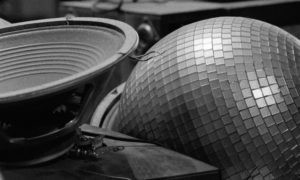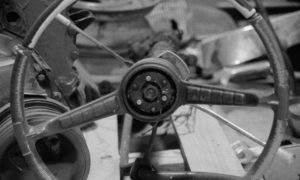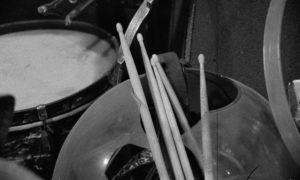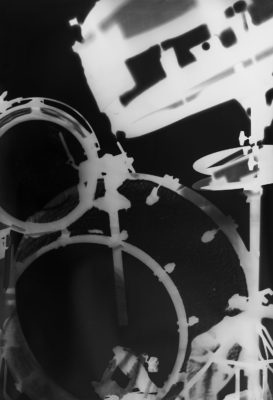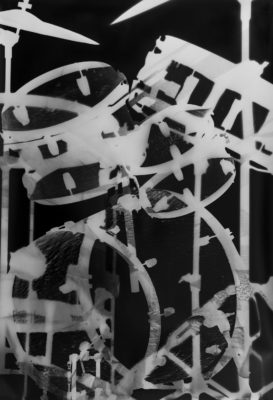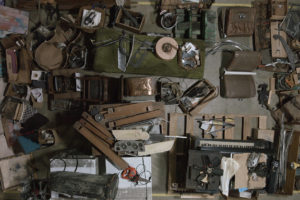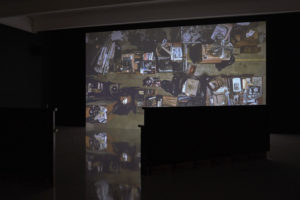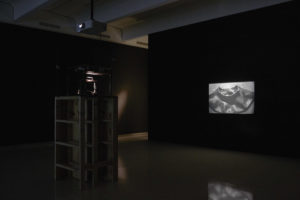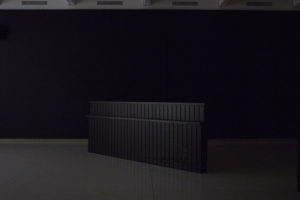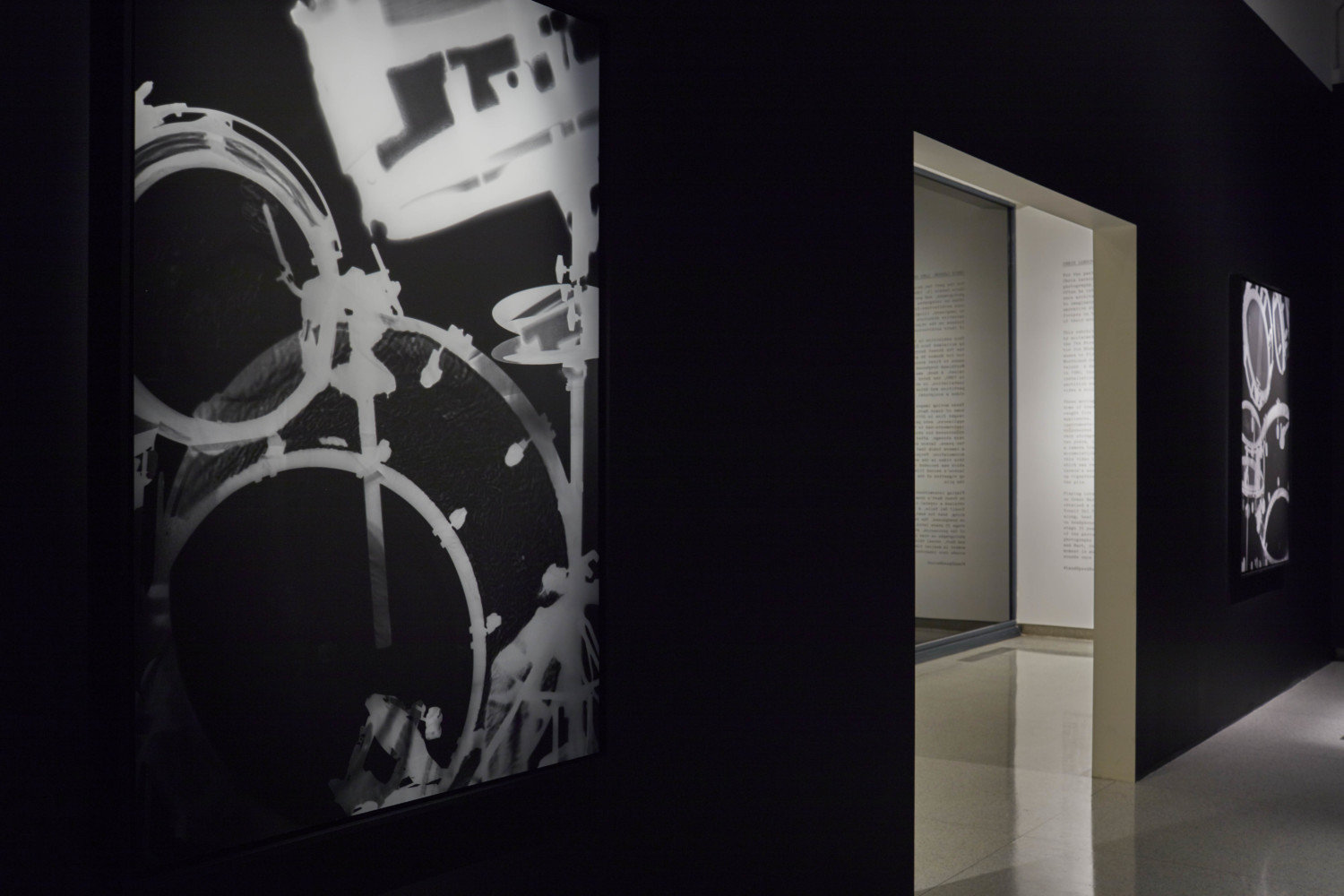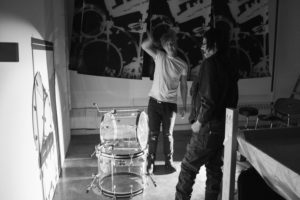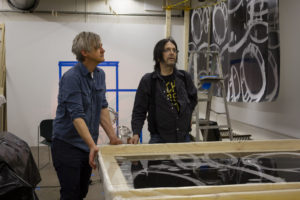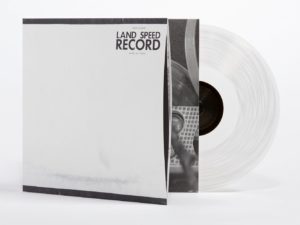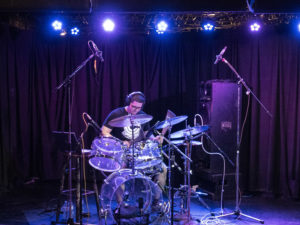Land Speed Record
16mm Film Stills, Running time 26:35
Land Speed Record #1-4
Silver Gelatin Photograms, 68″ x 42″
Video excerpt from Land Speed Record, Total running time 26:35
For the past two decades, Minnesota-based artist Chris Larson has developed a multimedia practice rooted in sculpture. His work incorporates film, video, photography, and performance as well as drawing and painting. Often he integrates these elements into sculptural installations that reference architecture—from iconic buildings by architects such as Marcel Breuer to ordinary rural cabins to imaginary, sometimes illogical structures—while building a unique narrative structure.
Land Speed Record focuses on objects and memories left behind when their architectural enclosure has disappeared. Titled after a live album by acclaimed Twin Cities punk band Hüsker Dü, the piece explores a group of smoke-blackened objects—including antiques, auto parts, rock ephemera, master tapes, and musical instruments—from the childhood home of band member Grant Hart, which were retrieved from a 2011 fire. Stored for several years in Larson’s studio, these became the basis for a meditative film installation that forms both a portrait of an artist and a tribute to a moment in alternative music history. Playing intermittently in the gallery is a recent recording duplicating Hart’s breakneck drum speed and precision on the original Land Speed Record album. Photographs on view, made by Larson and Hart, reveal the drum kit in shadow, layered with the memories of the spaces the sounds once inhabited.
Curators: Siri Engberg and Doug Benidt
— Siri Engberg, Walker Art Center
August 15, 1981 was a Saturday with temperatures in the 70s—on the cool side for the height of summer in Minneapolis. Diana Ross and Lionel Richie’s Endless Love was at number one on the Billboard Hot 100, and MTV had been on the air for precisely two weeks. This was uninteresting, though, to the crowd pushing into 7th St. Entry, a one-year-old, black-box annex to Sam’s Danceteria (months later to be rechristened First Avenue), a downtown music club in the former Northland-Greyhound bus depot fast becoming one of the Twin Cities’ premier music venues for emerging talent. They were here for punk rock, and for the homecoming of three young musicians from St. Paul: Grant Hart, Bob Mould, and Greg Norton—collectively known as Hüsker Dü—returning to town at the end of a tour they named the “Childrens’ Crusade.” The tour marked Hüsker Dü’s international breakout, as it began in Calgary and Victoria. It then meandered from Seattle to Portland to San Francisco and Sacramento and back to the Midwest through Chicago and Madison. But here at the Entry (as it was called by its regulars), Hüsker Dü was a fixture, having played the venue at least 50 occasions—sometimes several times in one week—since January 1980.
The cramped Entry—capacity 250—had been hewed from the bus depot’s former cloakroom and cafe. In its corner was the low-ceilinged stage, swathed in peeling black paint and scattered with plastic beer cups. It barely accommodated Hart, Mould, Norton, and Hart’s Ludwig drum kit, inherited at age 10 from his older brother, tragically killed by a drunk driver. The crowd in the smoke-filled room was partying, restless, waiting to experience the contagious energy that by now they knew well. Touring had tightened up the material, and new songs had been written on the road, so the band knew it was a moment to capture. Short on funds for a studio album, they had cobbled together $300 to record the show with the intent of releasing it as a live LP.
From the moment Hüsker Dü took the stage, the first set was unrelenting. It began with “All Tensed Up,” and proceeded to compress 17 songs into less than a half hour, kept on pace by Hart’s ferocious, high-speed drumming: insistent, decisive, with clear purpose. The LP would be called Land Speed Record and was released shortly thereafter with assistance from Mike Watt of The Minutemen and his label New Alliance. The jacket, like many hardcore punk and ska records of the time, was requisite black and white, its DIY graphics (designed by Hart via his pseudonymous Fake Name Grafx with Xerox copier and Sharpie marker) advocating the same urgency and immediacy as the music within. While less melodic and textured than Hüsker Dü’s subsequent albums, this one was special in its unruliness: it not only revealed a band on the verge of its collective potential, but also captured the essence of the venue that had been its incubator. For 26 minutes and 35 seconds within its enveloping black walls, 7th St. Entry became a creative tinderbox, encapsulated within Land Speed Record.
*
Eighteen year later, Hüsker Dü had disbanded, as had Hart’s subsequent band, Nova Mob. By the channels through which artists and performers often discover shared sensibilities, Grant Hart, now a solo performer, met artist Chris Larson. Both were from St. Paul, both had a fascination with a certain history of American culture, both understood music’s relationship to art. Their friendship through the years became a collaborative one: Hart appearing in Larson’s live performance work Shotgun Shack, and his film Crush Collision (both 2006), and Larson provided album art for Hart’s independent release, Good News for Modern Man (2014).
A musician in addition to being a visual artist, Larson has broad interests. His roots in sculpture have led him to explore film, video, photography, performance, drawing, and painting. His most memorable projects have stemmed from architecture—from vernacular building types (coal mine tipples, shotgun shacks) to imaginary, illogical structures—which inspire sculptural or filmic environments rooted in his skilled carpentry. These structures are layered with a strong narrative armature; he often lays plans within them for some unexpected action, such as the rural cabin in Deep North (2008) encrusted inside and out with ice and housing a strange, human-powered machine, or the floating house adrift on a lake in the film Crush Collision, in which a rough-hewn machine, a gospel quartet, and a drummer share parallel narratives and spaces within.
Larson’s work are often linked—a sculpture becomes a film set that then becomes photograph, for example—and are also regenerative, as an element used in one piece has the potential to appear again in another. While his earlier works embraced archetypal structures and improvised apparatus, more recent endeavors have investigated specific architectural sites. For Celebration/Love/Loss (2013), he meticulously constructed a full-scale wood-and-cardboard facsimile of the only Marcel Breuer-designed modernist home in the Twin Cities, then proceeded to torch it in a grand spectacle of flame. For Larson, the process of replication is a route to new meaning.
With Land Speed Record, his latest video installation, he focuses on the objects (and memories) left behind when their context and architectural enclosure have disappeared. In 2011, Hart’s childhood home in South St. Paul caught fire and partially burned. The smoke-blackened contents—furniture, appliances, antiques and collectibles, Studebaker parts, ephemera from gigs, art supplies, clothing, master tapes, guitars, and drums—had to be quickly cleared from the home, and Larson volunteered his studio as a storage space. For almost two years, the accumulation occupied the studio, itself a former warehouse for furniture in transit from factory to home. Hart would occasionally rearrange things on periodic visits, but Larson lived with and contemplated the items as they sat dormant, without framework or circumstance, unmoored from the house in which they had been collected, where Hart had learned to play the drums used at 7th St Entry on August 15, 1981.
Larson did not focus on the house. Instead, he began to build another machine, this time a motorized track for a camera that could provide new perspective and capture a slow, methodical pan across the 85-foot-long drift of Hart’s possessions. This became a pair of film—one in color, one in black and white—each mirroring the 26:35-minute duration of Land Speed Record. At first the films, at once reverential and haunting, were silent. But the work wasn’t finished. Larson began a new sculptural element, this time using the less physical materials of sound, memory, and place. He bought drums from Twin Town Guitars (“Keeping your life loud & local since 1997”)—a crystal-clear Ludwig Vistalite kit in mint condition. He commissioned a young musician with a passion for hardcore punk to learn the drum track of Land Speed Record in its entirety and to meet him at 7th St. Entry when he was ready. The empty venue was unlocked, lights turned on, and the transparent drum kit arranged on the stage. Quietly placed alongside it was a Ludwig snare, unearthed from the pile of burned objects. After recording equipment was set up, the musician, sticks poised, donned headphones. Seven seconds passed, during which one could faintly hear through his headset the sound of a crowd, a squeal of feedback, and the opening chords on Land Speed Record. Then he began drumming, playing with surgical precision alongside the recording of Hart. Live then and live now. This time, distilled and stripped away from band and crowd, Larson’s recording captured just two things: the crystalline syncopation and the walls of 7th St. Entry that carried its sound.
In Larson’s installation within the dark gallery space, this pure and specific sound is layered with sculpture (a replica of the venue’s black room divider/drink rail) and with the films. The sound interrupts, then fades through the filmed images, wrapping Hart’s inert and orphaned belongings in the moving image with the liveness of August 15, 1981. Recorded by the camera and scaffolded by sound, the charred objects are no longer ruins but are emancipated—they no longer require the enclosure of the house, the studio, or specific recollections.
When Land Speed Record hit stores just before Christmas 1981, a local critic admiringly called it “a repository of strength and horror” (City Pages). For Larson, the notion of the repository remains rich and spacious, filled with the possibility for reinvention. Likewise, the vestiges of what a space has once held, whether objects, sounds, words, or memories, can perpetually be re-embodied. In Larson’s Land Speed Record, these remnants layer to form a larger narrative. Hüsker Dü was playfully named for a family board game that tests one’s ability to recall images: a childhood home, a music venue, a furniture warehouse. The words are Norwegian for “do you remember?”
— Siri Engberg, “The Tinderbox”
Limited-Edition Vinyl LP
Accompanying the exhibition is a clear vinyl LP containing a duplicate version of Hüsker Dü’s original drum track played by Yousif Del Valle and recorded live at 7th St Entry in April 2016. Published by the Walker, the album serves as the catalogue for Larson’s exhibition and includes liner notes by Walker exhibition curator Siri Engberg, Walker artistic director Fionn Meade, independent curator Dieter Roelstraete, and Rev. Russell Rathbun, a writer and founding preacher at the St. Paul–based church House of Mercy. A separate, deluxe limited-edition LP additionally features a color photograph, signed and numbered by Larson, of the accumulation of salvaged objects that are the subject of his film.
